Eclipse Viewing Setting in Vicuña
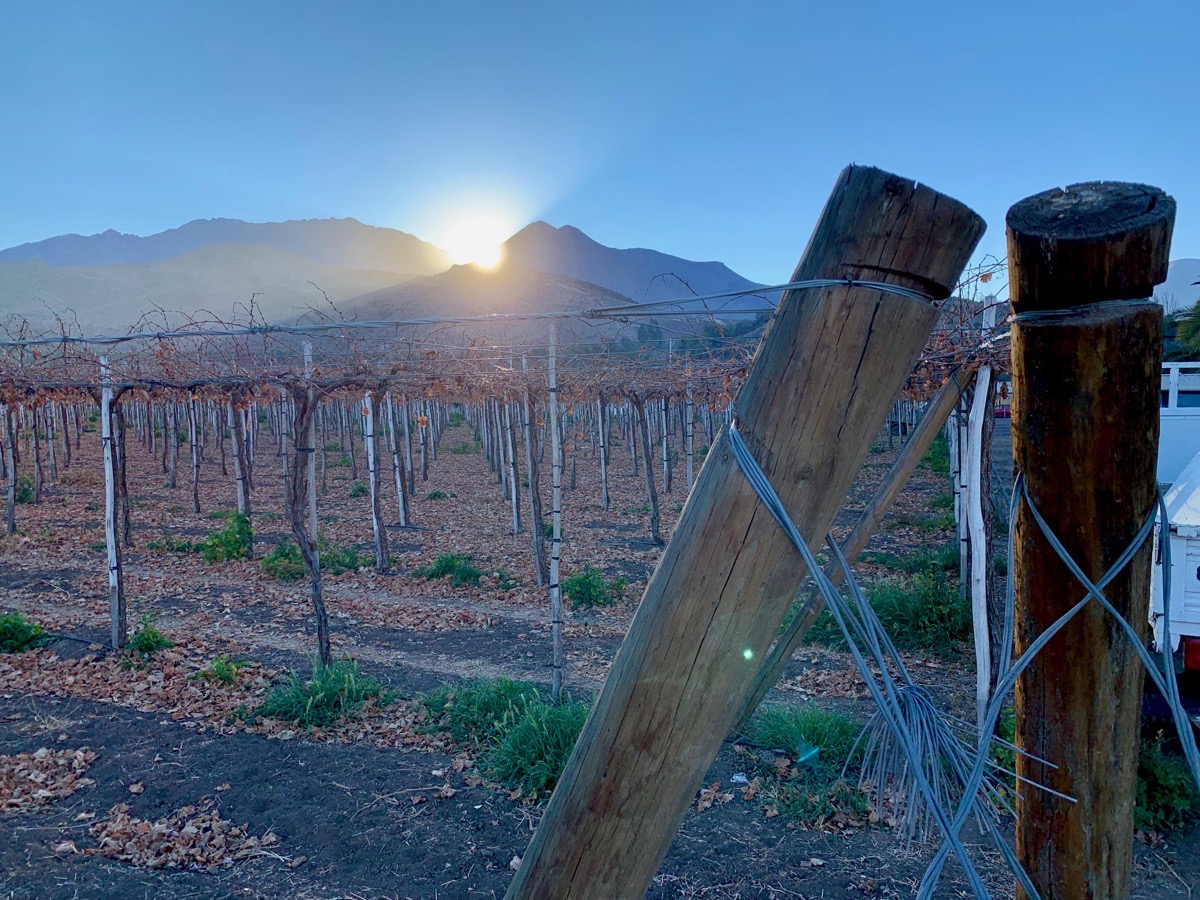
Allison and I were fortunate enough to be able to view another total solar eclipse, this time from a vineyard in a small town called Vicuña in Chile. We traveled to Chile as part of a UCLA Alumni group tour and viewing the solar eclipse was one of the highlights of this tour. We arrived in Vicuña just before sunrise, about 7 hours before the eclipse was to begin so we wondered if there would be any shelter from being out in the elements all day.
When we arrived and saw what the UCLA Alumni group had arranged for us, our concerns were immediately dispelled. They had set up a large white tent with tables, table cloths, and chairs so we could get off our feet and out of the sun if we needed a break. They also used this area to serve a fantastic lunch before the eclipse and fine dinner afterward.
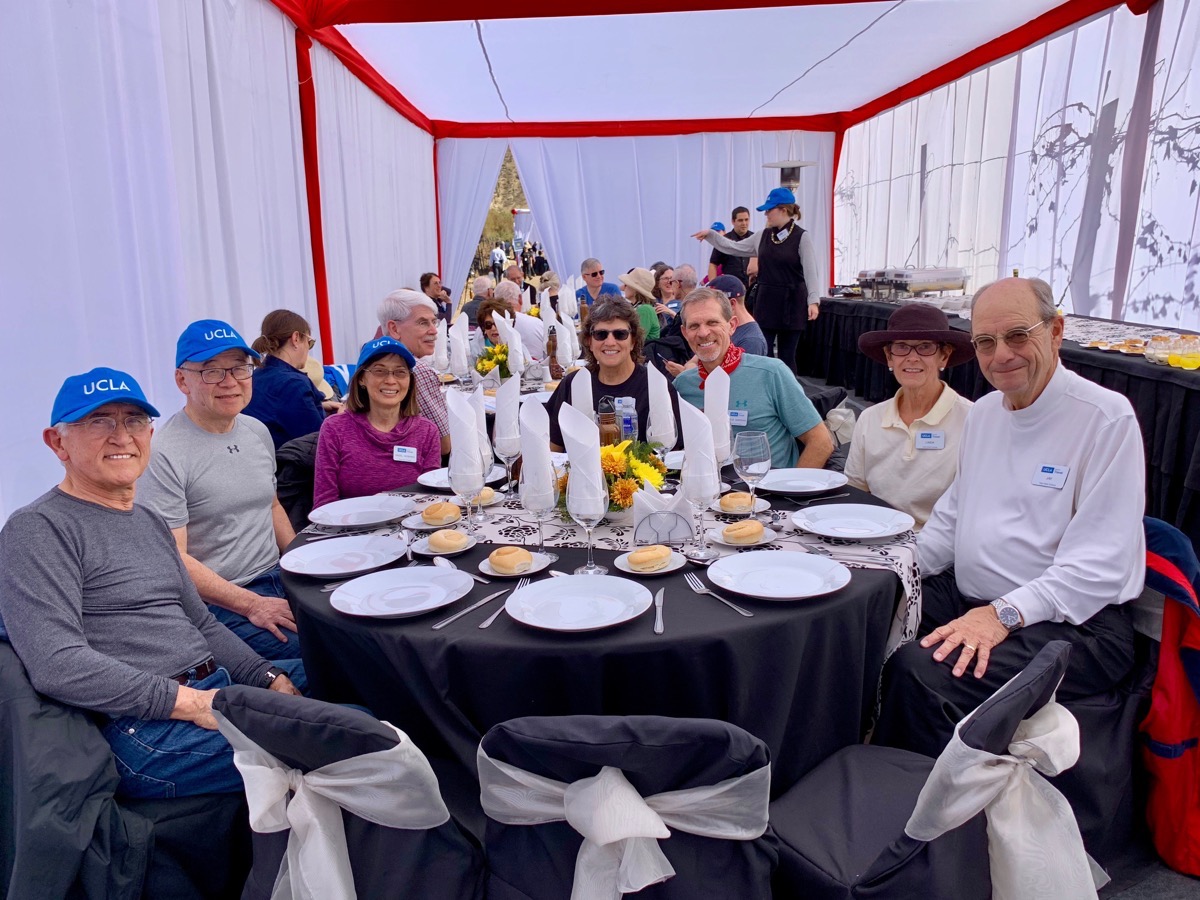
They did it up right. It turns out that, other than the meals, we didn’t spend much time in the tent since there were several other activities prior to the eclipse that kept us busy. The weather in Vicuña that day was marvelous for viewing an eclipse. There were no clouds, temps were in the low 70’s, and the wind was moderate (more about that later). This eclipse was scheduled to occur relatively late in the day in Vicuña, with totality ending at 4:41 pm and sunset less than 40 minutes later.
Setting Up and Filming the Eclipse
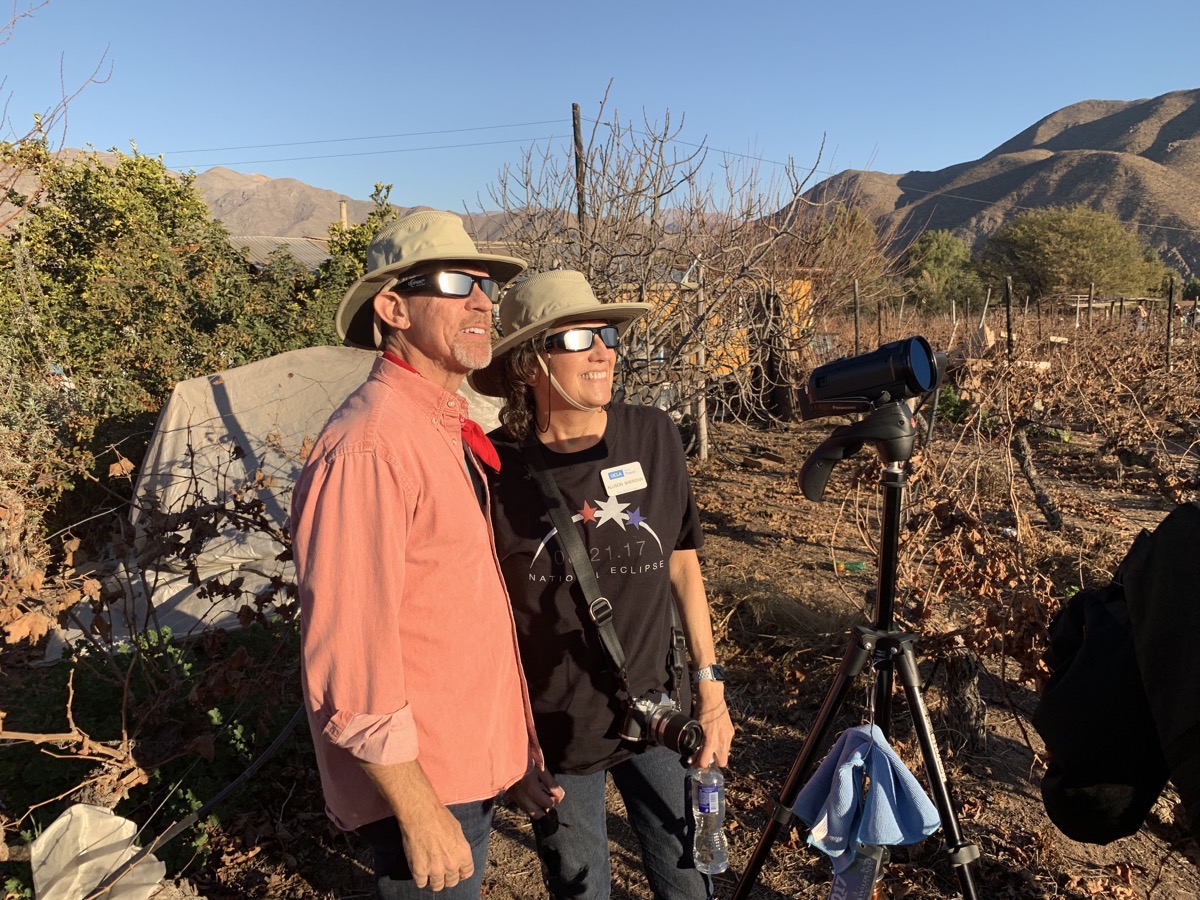
This was Allison and my third viewing and recording of a total solar eclipse. I shot video of the prior two eclipses (in 2012 off the coast of Australia and in 2017 in Oregon) and was prepared to shoot this one as well. You can read about our experiences of photographing and video recording the Great American Eclipse from Oregon in this blog post from August 2017: How Do You Capture a Total Eclipse … and Still Experience It?. Much of the preparation and execution of recording this year’s eclipse is similar to how I recorded the 2017 eclipse, although there were some differences that I’ll note. As it was for the 2017 eclipse, my goal was to capture this eclipse on video without being distracted from viewing the event directly and I was fairly successful at accomplishing that goal.
To record this eclipse, I used two cameras: a Panasonic HC-V770 camcorder and a GoPro Hero5 Black. I used the camcorder to capture close-up video of the eclipsed sun, taking advantage of the camera’s 1080p resolution, 20x optical zoom, and image stabilization. I used the GoPro to record wide angle shots of the audience and their surroundings as they watched the eclipse unfold.
Preparation is key for successfully recording a total solar eclipse. An important aspect of recording any long-duration event is to have a stable base for your camera. Well before the eclipse began, I secured my GoPro to a tall post in the vineyard using a small JOBY Gorillapod with flexible legs and positioned it to face the audience as they viewed the eclipse. I mounted my camcorder to a Manfrotto tripod and positioned it sufficiently far from the audience that I would avoid the unfortunate experience of someone stepping into the camera’s field of view while I was recording. I also hung a metal thermos full of water to the center post of the tripod for extra stability. I’m glad I did this because there was more wind during this eclipse than the prior eclipses we experienced. Even with a stable tripod, the camcorder was buffeted slightly by the wind and this caused a bit of jitter during the close-up of the sun, but not too much.
A tricky aspect of recording any celestial body for a period of time, particularly when zoomed up, is accounting for and centering that body since it will travel across the video frame. There’s a trade-off here since if you zoom in too much, the sun will travel through the camera’s field of view before the eclipse is over. But if you zoom back too much, you lose some detail of the eclipsed sun. My goal was to record the sun starting a couple of minutes before totality began and ending a couple of minutes after totality concluded with the lens zoomed up as far as possible and without the sun traveling out of the camera’s frame. Also, I did not want to reposition the camera or change its settings during the recording. Shooting it this way allowed me to get the best resolution of the eclipsed sun without losing any of its image as it traveled across the sky.

One of the changes to recording this total eclipse from the prior two eclipses was my camera settings. This time around, I wanted to keep my cameras’ exposure settings fixed to achieve some effects I missed in the other eclipses. My goal for the GoPro shot was to capture the audience’s reaction to the sun as it entered totality but, this time, to also show how quickly the surrounding area darkens due to the eclipse. Using auto-exposure on the GoPro would automatically lighten up the darkening scene, completely negating the effect I was looking for, so I set the GoPro to properly expose during daylight and fixed this setting.
In recording the prior two eclipses, I left my camcorder in auto-exposure mode. This achieves an effect where the corona surrounding the totally eclipsed sun shows very brightly. You can see the sun’s bright corona in the photo Allison took of the eclipse. However, a very bright corona swamps out the subtle details of the dimmer solar prominences that I wanted to pick up. A solar prominence is a bright, gaseous feature extending outward from the Sun’s surface, often orange or red in color and shaped in a loop. For the eclipse close-up using the camcorder, my goal was to capture more detail of the prominences that often are visible during a total solar eclipse. So like the GoPro, I set the camcorder to properly expose the fully-lighted sun (with a solar filter applied, of course) and fixed this setting.
Timing is Everything
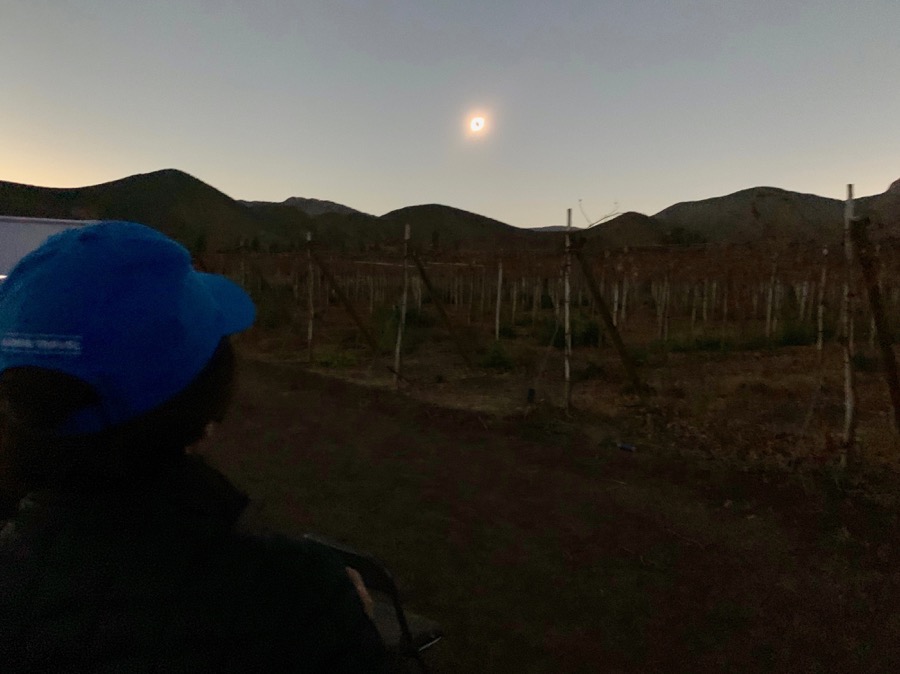
One of the convenient aspects of recording an eclipse is that you know precisely (down to the second) when the eclipse will occur and where in the sky it will appear. Totality for this eclipse started at 4:38:34 pm local and lasted for 2 minutes, 25 seconds with an eclipse midpoint time of 4:39:46 pm. At that time, the sun would be only 13 deg above the horizon, thus my concern about people potentially stepping in front of my camera as I was recording. I was able to roughly set my camcorder’s azimuth position for the eclipse midpoint using the Compass app and its elevation angle using the Level app on my iPhone.
Since I wanted to record a couple of minutes before and after totality, I needed the sun to stay in the camera frame as it traveled across the sky for about a 6.5-minute interval during which time I would not reposition the camera or change its settings. Prior to the eclipse, I adjusted the zoom using the partially eclipsed sun to ensure the sun would appear fully in the upper right of the video frame and travel across for 6.5 minutes to the lower left of the frame. Then, at 3 min 15 sec before the midpoint of the eclipse (which is half of the 6.5-minute sun travel time) and with the zoom at the same setting, I positioned the nearly eclipsed sun to appear in the upper right of the video frame, started the recording, and didn’t touch the camera other than to remove and reattach the solar filter. Of course, I used the alarm on my Apple Watch to let me know when to position the camera and start the recording. This process worked fairly well, although the sun was a bit farther down in the frame than I would’ve liked. But I was successful in capturing a zoomed up eclipsed sun with all of its detail during totality and the special moments before and after totality.
Another important aspect of recording a solar eclipse is protecting your camera (and your eyes) from direct sunlight. I used a HOYA ND100000 solar filter to protect the camcorder’s sensor. I removed the solar filter a few seconds before totality began and reattached it a few seconds after totality concluded. Removing and reattaching the solar filter is the only time that I touched the camcorder while recording the eclipse. This is a screw-on filter which can be somewhat cumbersome to remove and re-attach and can result in some camera jitter. To keep the removal/attachment times as brief as possible, I partially unscrewed the filter prior to the recording so that only a half turn was sufficient for removing the filter. Likewise, I only used a half turn to reattach the filter.
Editing the Eclipse Video
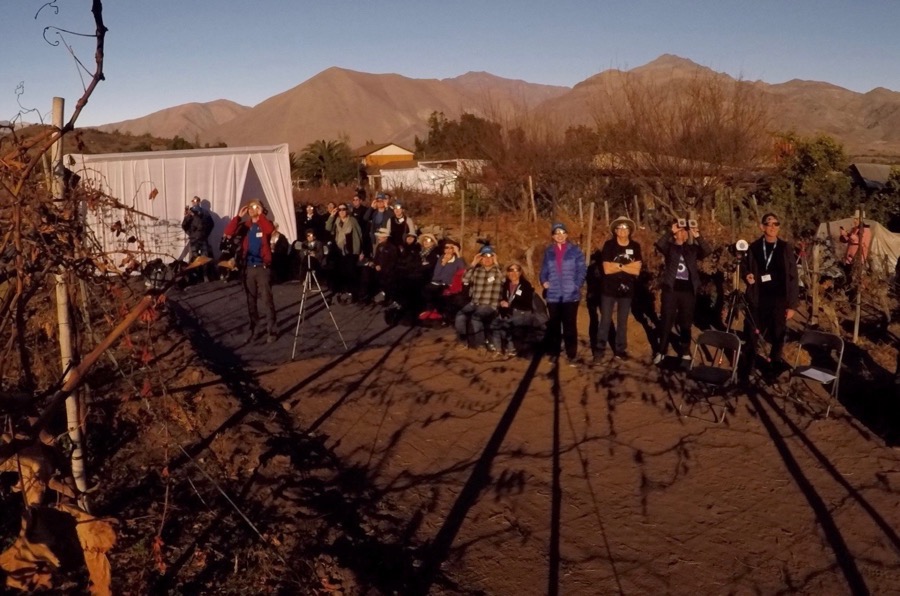
In order to capture what it was like to view the eclipse and achieve all of the effects I was looking for, I used three video clips I shot from the two cameras and edited them together: 1) the audience as they view the eclipse prior to totality, 2) the eclipse itself as it enters, transitions through, and exits totality, and 3) the partially eclipsed sun as it sets on the horizon.
For the period leading up to totality, I cut between the eclipse itself and the audience viewing the eclipse, with focus on the audience just as totality approaches and focus on the sun as totality is achieved. During the scenes showing the audience, you can see moving shadow bands on the ground which we had not seen during our prior two eclipses. Shadow bands appear as alternating light and dark bands that undulate in parallel on the ground. The bands are caused by the narrow slit of light from the solar crescent being refracted by turbulent air in the atmosphere. It’s not clear why we hadn’t observed this effect during our prior two eclipses, but I suspect we were just too awestruck by the eclipse itself to notice anything happening on the ground.
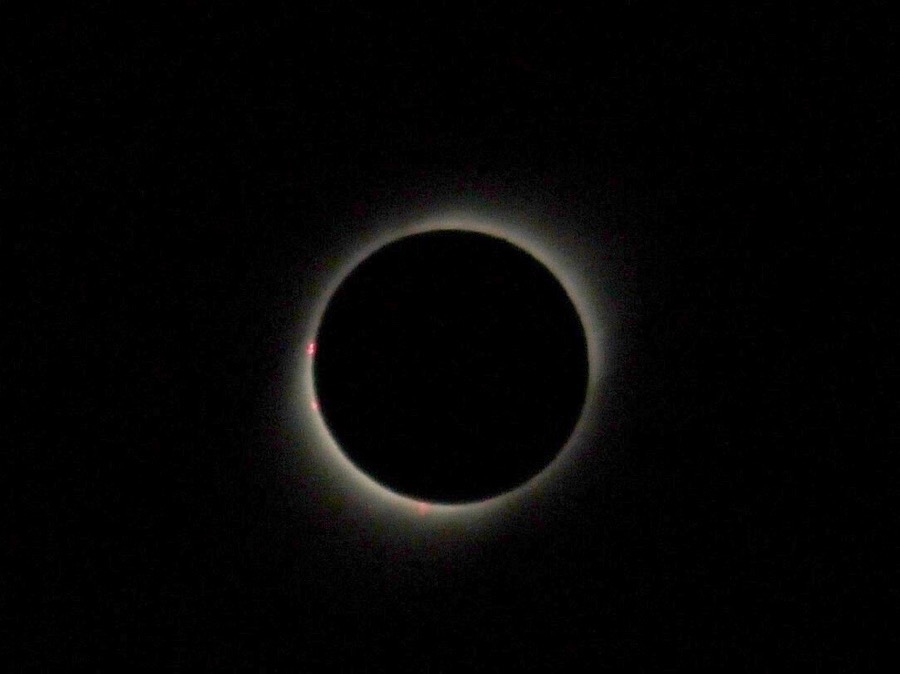
I mentioned earlier that I attempted to achieve a couple of different effects by fixing my cameras’ exposure settings. I was pleased to see that both effects were achieved. You can see the vineyard and grounds surrounding the audience dim rapidly as totality approaches and you can view the near-total darkness falling on the audience as their reaction to the sun entering totality swells. With this view, you get a sense of how wondrous the sight is by the whoops and hollers from the audience as totality begins. I compressed the following 2 minute 25 second period of totality by a factor of 5:1 so you can see the fully eclipsed sun traveling across the sky. With a fixed exposure for this zoom shot, the corona was a bit dim, but three red solar prominences were clearly visible in the lower-left quadrant of the eclipsed sun.
During an eclipse, there are two spectacularly brilliant moments right before totality begins and after totality ends. This occurs when the moon is about to fully cover the sun, leaving a ring (the sun’s corona) surrounding the moon highlighted by a very bright but small spot of the still exposed sun, and this occurs again on the other side of the eclipse when the sun just exits from full totality. For obvious reasons, this effect is called the diamond ring and it’s a sight to behold. Since the diamond ring happens quickly, I don’t use time-lapse but rather real-time video during this phase to relish every moment.
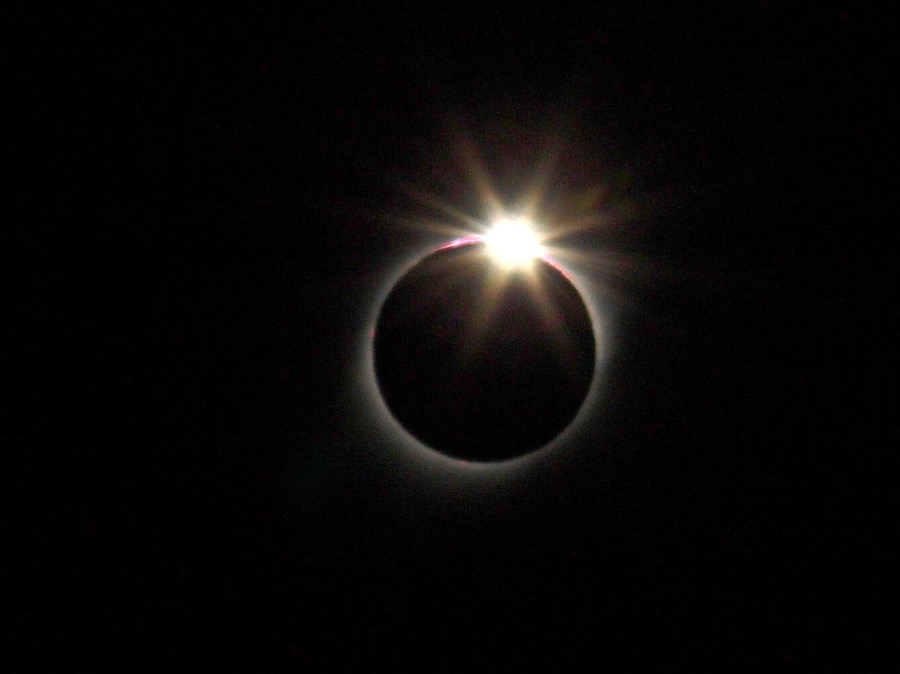
I think music and its precise timing with key events in a video play an important role in increasing the viewer’s interest. But it’s also important NOT to use music during certain times. To ensure the audience’s reaction to the eclipse was the central focus leading to up totality, I used only the background audio from the audience recorded by the GoPro and camcorder with no music. As the eclipse enters totality, I wanted to shift focus from the audience to the sun, so I gradually lowered the audience audio track and faded in a suitably ethereal instrumental song which ends as the eclipse concludes.
I mentioned that the total eclipse occurred only about 40 minutes before sunset. This gave me the opportunity to capture another somewhat rare event: a partially-eclipsed sun setting over a not-so-distant mountain. Again, I wanted focus on the sun so I muted the video’s audio track and added in an instrumental song that concludes just as the partially-eclipsed sun sets. All in all, I’m happy with how the video turned out.
The Result
Using a Screen Reader? click here
One of the advantages of shooting a solar eclipse (or any event) with a video camera is that if anything unusual and sudden happens, you’ll likely capture it. Well, just as the partially-eclipsed sun was setting, a remarkable sight in its own right, a hawk happened to fly in front of the setting sun. I’ll leave you with this last video clip where three natural events needed to coincide for this sight to be witnessed.
In summary, planning and preparation are key to successfully recording a total solar eclipse. I’m thankful that Allison and I were able to travel to Chile and view this rare event and I’m very pleased that everything went well. I’m also confident that this will not be our last solar eclipse viewing experience.

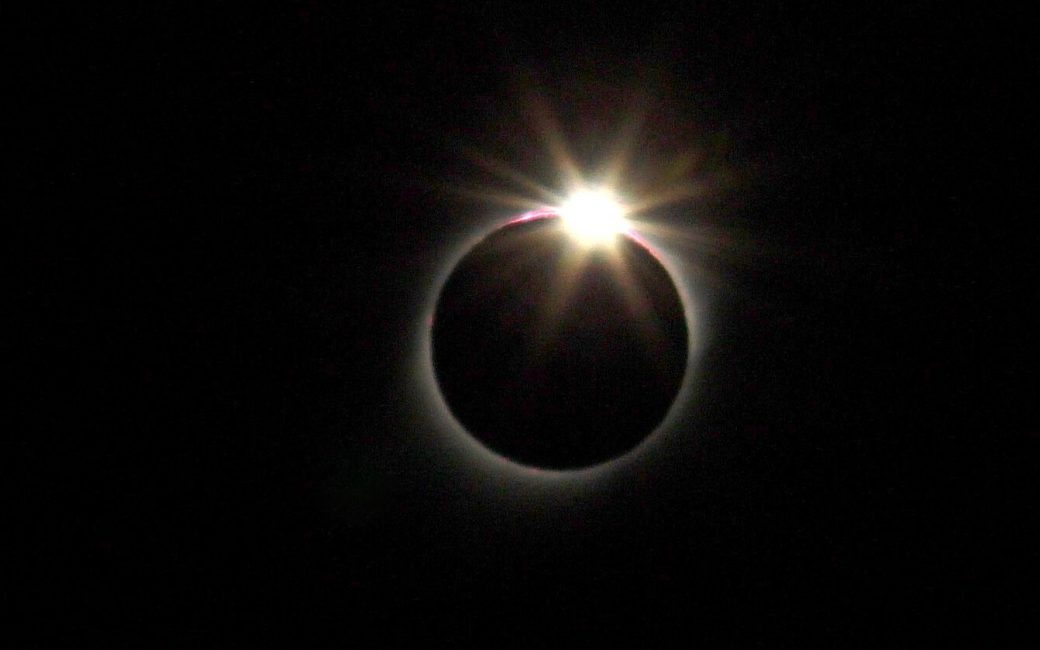
Steve – absolutely wonderful. Your advanced planning really paid off.
Congratulations on bringing us a totally marvellous blog post and podcast segment about your Chilean eclipse adventure, Steve. In particular, I was impressed at your determination to include the human element in your photos and videos. For someone who wasn’t at the event, seeing the smiling faces and hearing their reactions was a wonderful way of getting a feel for what you all experienced.
I enjoy your writing style, and your narration of it on the Nosillacast was excellent. You sound quite a bit younger in the recording than I know you to be. Are you familiar with Oscar Wilde’s “The Picture of Dorian Gray”? In your case, it would be “The Recording of Steve Sheridan”.
I met you & Allison in Sydney back when you came down for your cruise that took in the Total Solar Eclipse off Cairns, Australia. Since then you’ve seen two others and I’ve seen exactly zero, so I’m mightily envious of you guys! Keep up the great work producing pieces like this, as well as your work at the conferences and trade shows. Most of all–and I know you won’t need any encouragement to do this–keep on helping Allison to be the wonderful podcaster and community hero that she is.
Why, thank you Doug. So happy to see that you noticed exactly what I was trying to capture in the video: the group’s feeling of awe as the eclipse entered totality.
No one has told me before that I sound younger than I am. Regarding your reference to “The Picture of Dorian Gray,” does that make me the portrait in the attic?
I distinctly remember meeting you at the meet-up in Sydney. We had a great time that night. And yes, I think we’ve become eclipse chasers, although we’re not quite sure when our next one will be. Possibly the one that passes through the central part of the U.S. in 2024. Do you have any total eclipses passing through Australia? If you do, I highly recommend traveling to the location where the eclipse will be in totality and not settle for a partial eclipse. They are completely different viewing experiences.
Certainly, I will continue to do all I can to help Allison with the NosillaCast. It’s a fun venture for both of us, mainly because we meet new and fun people, like you.
[…] From Dean and Suzanne’s we traveled to Torrey, a small town in southern Utah. We chose Torrey since it was in the path where the annular solar eclipse would be fully formed. From this location, we were able to view the sun for a little over 4 minutes while the moon was perfectly centered over it. Unlike a total solar eclipse where the moon fully covers the sun leaving just the glowing corona surrounding the moon, during an annular eclipse, the moon is farther from the earth and thus appears smaller than the sun. As a result, the moon doesn’t completely cover the sun but instead creates the classic “ring-of-fire” spectacle. You can read about our exploits in filming a total solar eclipse from our trip to Vecuña, Chile in 2019 here Capturing the 2019 Chile Solar Eclipse on Video. […]